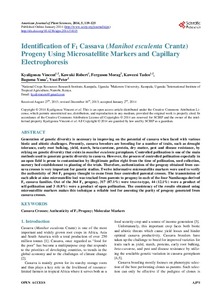| dc.contributor.author | Kyaligonza, V. |
| dc.contributor.author | Kawuki, Robert S. |
| dc.contributor.author | Ferguson, M. |
| dc.contributor.author | Kaweesi, T. |
| dc.contributor.author | Baguma, Yona K. |
| dc.contributor.author | Vuzi, P. |
| dc.date.accessioned | 2019-12-04T11:03:23Z |
| dc.date.available | 2019-12-04T11:03:23Z |
| dc.date.issued | 2014 |
| dc.identifier.citation | Kyaligonza, V., Kawuki, R.S., Ferguson, M., Kaweesi, T., Baguma, Y. & Vuzi, P.(2014). Identification of F1 Cassava (Manihot esculenta Crantz) progeny using microsatellite markers and capillary electrophoresis. American Journal of Plant Sciences, 5, 119-125. |
| dc.identifier.issn | 2158-2742 |
| dc.identifier.uri | https://hdl.handle.net/20.500.12478/1031 |
| dc.description.abstract | Generation of genetic diversity is necessary in improving on the potential of cassava when faced with various biotic and abiotic challenges. Presently, cassava breeders are breeding for a number of traits, such as drought tolerance, early root bulking, yield, starch, beta-carotene, protein, dry matter, pest and disease resistance, by relying on genetic diversity that exists in manihot esculenta germplasm. Controlled pollination is one of the main methods used to generate genetic diversity in cassava. However, the process of controlled pollination especially in an open field is prone to contamination by illegitimate pollen right from the time of pollination, seed collection, nursery bed establishment to planting of the trials. Therefore, authentication of the progeny obtained from cas-sava crosses is very important for genetic studies. Twelve informative microsatellite markers were used to verify the authenticity of 364 F1 progeny thought to come from four controlled parental crosses. The transmission of each allele at nine microsatellite loci was tracked from parents to progeny in each of the four Namikonga-derived F1 cassava families. Out of the 364 F1 progeny, 317 (87.1%) were true-to-type, 44 (12.1%) were a product of self-pollination and 3 (0.8%) were a product of open pollination. The consistency of the results obtained using microsatellite markers makes this technique a reliable tool for assessing the purity of progeny generated from cassava crosses. |
| dc.format.extent | 119-125 |
| dc.language.iso | en |
| dc.subject | Progeny |
| dc.subject | Genetic Markers |
| dc.title | Identification of F1 cassava (Manihot esculenta Crantz) progeny using microsatellite markers and capillary electrophoresis |
| dc.type | Journal Article |
| dc.description.version | Peer Review |
| cg.contributor.crp | Roots, Tubers and Bananas |
| cg.contributor.affiliation | National Crops Resources Research Institute, Uganda |
| cg.contributor.affiliation | Makerere University |
| cg.contributor.affiliation | International Institute of Tropical Agriculture |
| cg.coverage.region | Africa South Of Sahara |
| cg.authorship.types | CGIAR and developing country institute |
| cg.iitasubject | Cassava |
| cg.journal | American Journal of Plant Sciences |
| cg.howpublished | Formally Published |
| cg.accessibilitystatus | Open Access |
| local.dspaceid | 77960 |
| cg.identifier.doi | https://dx.doi.org/10.4236/ajps.2014.51015 |

